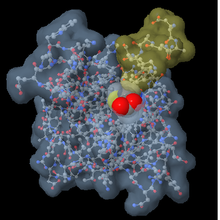
Back جمول Arabic Jmol Catalan Jmol German Jmol Greek Jmol Spanish جیمول FA Jmol French Jmol GL Jmol ID Jmol Italian
 | |
 Jmol three-dimensional structure rendering of streptavidin | |
| Developer(s) | Jmol development team |
|---|---|
| Initial release | 2001 |
| Stable release | |
| Repository | sourceforge |
| Written in | Java |
| Operating system | Cross-platform |
| Platform | Systems with Java and Web browsers without Java |
| Available in | 24 languages |
List of languages Basque, Catalan, Chinese (CN and TW), Czech, Danish, Dutch, English (GB and US), Finnish, French, German, Hungarian, Indonesian, Italian, Japanese, Korean, Malay, Portuguese (BR), Russian, Spanish, Swedish, Turkish and Ukrainian [1] | |
| Type | Molecular modelling |
| License | LGPL 2.0 |
| Website | www |
Jmol is computer software for molecular modelling of chemical structures in 3 dimensions.[2] It is an open-source Java viewer for chemical structures in 3D[3]. The name originated from [J]ava (the programming language) + [mol]ecules, and also the mol file format.
JSmol is an implementation in JavaScript of the functionality of Jmol.[4] It can hence be embedded in web pages to display interactive 3D models of molecules and other structures without the need for any software apart from the web browser (it does not use Java).
Both Jmol and JSmol render an interactive 3D representation of a molecule or other structure that may be used as a teaching tool,[5] or for research, in several fields, e.g. chemistry, biochemistry, materials science, crystallography,[6] symmetry or nanotechnology.
- ^ Jmol translations
- ^ Chen, Jim X. (2008), Springer (ed.), Guide to Graphics Software Tools, p. 471, ISBN 978-1-84800-900-4
- ^ "How to cite Jmol".
- ^ "JSmol". Retrieved 2025-01-11.
- ^ Herráez, A (2006), "Biomolecules in the Computer: Jmol to the Rescue", Biochemistry and Molecular Biology Education, 34 (4): 255–61, doi:10.1002/bmb.2006.494034042644, PMID 21638687, S2CID 36319720
- ^ Hanson, Robert M. (2010), "Jmol – a paradigm shift in crystallographic visualization", Journal of Applied Crystallography, 43 (5): 1250–1260, doi:10.1107/S0021889810030256